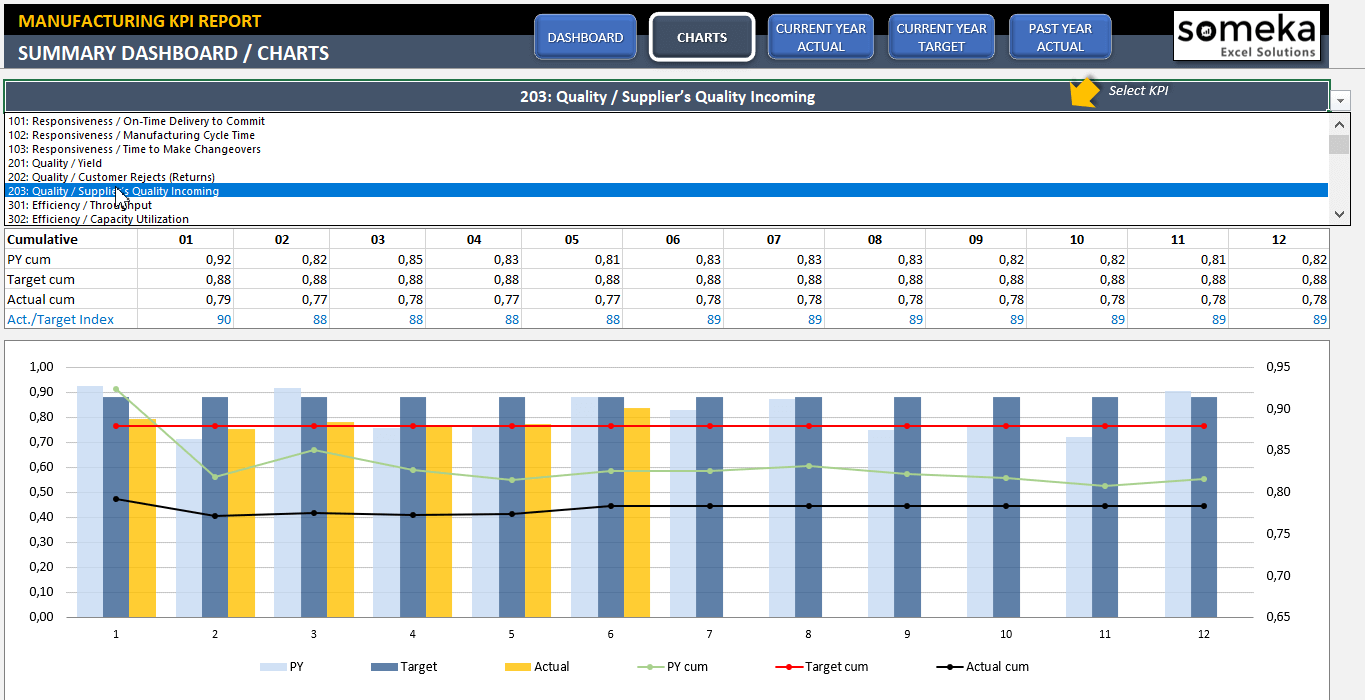
Kpi Dashboard Template
We've assembled a collection of key performance indicators (KPIs) and metrics. These KPIs are grouped by both department and industry. KPI Examples. Performance management starts with figuring out what to measure. Back to Learn.
The procurement department is a function that is found in most of the companies, whichever their type and industry: it is not limited only to manufacturers of products and goods, but is also a business unit for services companies, working with freelancers, agencies, etc.  It is a strategic function linking the needs of a firm, and the suppliers or contractors. It plays a key role in the competitiveness of an organization. Our first procurement KPI dashboard provides an overview of the various metrics a procurement department works with. The first KPIs displayed are some statistics about the suppliers. Among the 804 suppliers, 61% are contracted, meaning that they agreed with the compliance contract of the contracting company, while 39% preferred not to settle on basic agreements – but still work with the company, as unlisted suppliers.
It is a strategic function linking the needs of a firm, and the suppliers or contractors. It plays a key role in the competitiveness of an organization. Our first procurement KPI dashboard provides an overview of the various metrics a procurement department works with. The first KPIs displayed are some statistics about the suppliers. Among the 804 suppliers, 61% are contracted, meaning that they agreed with the compliance contract of the contracting company, while 39% preferred not to settle on basic agreements – but still work with the company, as unlisted suppliers.
These basic agreements encompass various requirements such as the delivery time, the reaction time, special discounts, etc. Festo fluidsim kostenlos deutsch test online game. The contracted suppliers can then be classified and get certain partner status like gold, silver, or bronze – usually awarded to the ones that provide the company with good terms of agreements, interesting discounts, who take care of the relationship with the company. On the right part are exposed the costs and savings trends over five years. We see that the suppliers account for over two million euros in spending, but that the procurement department managed to save more than €96,000. The second KPI displayed on that procurement KPI dashboard focuses on the compliance rate per category: the highest compliance rate goes to the first category, that also has the highest number of suppliers, with 75% rate of contract compliance for 610 suppliers. The lowest rate goes to the fourth category with 9% contract compliance for 29 suppliers. Moving forward onto the final metric on this procurement KPI dashboard, we have an illustration of the average procurement cycle time expressed in days.
This cycle time covers the end-to-end ordering process, from the order placement to the confirmation, order delivery, and finally the invoicing. Here, we see that the overall average is of 7.2 days, with the moment between the confirmation and the delivery of the order for the invoice being the longest (5.2 days). Working with interactive dashboards summarizing the procurement department's activities and relationship with suppliers, or highlighting procurement's actual results (as we will see on our last dashboard) will not only help in managing the department, but also in building its brand.
These dashboards are a real help for top management decision-makers and strategy builders. Having an overview and monitoring all your processes from purchase orders management to knowing your different types of suppliers will let you optimize your procurement process and more generally, the profitability of your company. Our second procurement dashboard focuses on a supplier’s ability to provide you with the right products or services, at the right moment. The first KPIs displayed at the top give an overview of one supplier’s performance, while the lower part of the dashboard is a snapshot of the overall performance of several different suppliers. With an interactive dashboard tool like datapine's, you can easily add filters on your dashboard and focus on a specific supplier's performance, compare it to others or to the overall. The defect rate is a metric used to measure how many products received are not meeting the quality requirements and compliance specifications.
For this particular supplier, it is of 1.9% and the trend line has been rather irregular over time; he or she managed however to maintain that rate under the maximum defect rate of 2.5% except in two points. This defect rate can be further compared to the rest of the suppliers with the bottom left chart displaying each supplier’s defect rate broken down into types of defect.